Triplet Loss、Coupled Cluster Loss 探究
2016-07-25 20:49
381 查看
Preface
因为要区分相似图像,所以研究了一下 Triplet Loss,还有今年 CVPR 的一篇文章:《Deep Relative Distance Learning: Tell the Difference Between Similar Vehicles》,这篇文章提出了 Coupled Cluster Loss 。文章的主要内容在之前的阅读笔记已经叙述过了,文本主要集中于对这两个损失函数的实验部分。
Triplet Loss
Triplet Loss 的 Torch 实验
Triplet Loss 的 Torch 实现,有人已经做好了。只需看懂即可,看看是怎么做的。为接下去实现 Coupled Cluster Loss 做好准备。具体参见这里的 Github 仓库,Google 的《FaceNet: A Unified Embedding for Face Recognition and Clustering 》 论文就是用的这个 Triplet Loss 实现 ,代码参见:https://github.com/cmusatyalab/openface
贴上主要实现部分:
--------------------------------------------------------------------------------
-- TripletEmbeddingCriterion
--------------------------------------------------------------------------------
-- Alfredo Canziani, Apr/May 15
-- Xinpeng.Chen --
--------------------------------------------------------------------------------
local TripletEmbeddingCriterion, parent = torch.class('nn.TripletEmbeddingCriterion', 'nn.Criterion')
function TripletEmbeddingCriterion:__init(alpha)
parent.__init(self)
self.alpha = alpha or 0.2
self.Li = torch.Tensor()
self.gradInput = {}
end
function TripletEmbeddingCriterion:updateOutput(input)
local a = input[1] -- anchor
local p = input[2] -- positive
local n = input[3] -- negative
local N = a:size(1) -- N is batchSize, represent the N in the formula
self.Li:resize(N)
for i = 1, N do
self.Li[i] = math.max(0, (a[i] - p[i]) * (a[i] - p[i]) + self.alpha - (a[i] - n[i]) * (a[i] - n[i]))
end
self.output = self.Li:sum() / N
return self.output
end
function TripletEmbeddingCriterion:updateGradInput(input)
local a = input[1] -- anchor
local p = input[2] -- positive
local n = input[3] -- negative
local N = a:size(1) -- N is batchSize, represent the N in the formula
if torch.type(a) == 'torch.CudaTensor' then -- if buggy CUDA API
self.gradInput[1] = (n - p):cmul(self.Li:gt(0):repeatTensor(a:size(2),1):t():type(a:type()) * 2/N)
self.gradInput[2] = (p - a):cmul(self.Li:gt(0):repeatTensor(a:size(2),1):t():type(a:type()) * 2/N)
self.gradInput[3] = (a - n):cmul(self.Li:gt(0):repeatTensor(a:size(2),1):t():type(a:type()) * 2/N)
else -- otherwise
self.gradInput[1] = self.Li:gt(0):diag():type(a:type()) * (n - p) * 2/N
self.gradInput[2] = self.Li:gt(0):diag():type(a:type()) * (p - a) * 2/N
self.gradInput[3] = self.Li:gt(0):diag():type(a:type()) * (a - n) * 2/N
end
return self.gradInput
endTriplet Loss 示意图及其 Loss Function
Triplet Loss 的示意图及其损失函数如下:
损失函数为:
L=∑Nmax{∥∥f(xa)−f(xp)∥∥22+α−∥∥f(xa)−f(xn)∥∥22, 0}
Triplet Loss 中 margin 取值分析
我们的目的就是使 loss 在训练迭代中下降的越小越好,也就是要使得 Anchor 与 Positive 越接近越好,Anchor 与 Negative 越远越好。基于上面这些,分析一下 margin 值的取值。当 margin 值越小时,loss 也就较容易的趋近于 0,于是 Anchor 与 Positive 都不需要拉的太近,Anchor 与 Negative 不需要拉的太远,就能使得 loss 很快的趋近于 0。这样训练得到的结果,不能够很好的区分相似的图像。
当 Anchor 越大时,就需要使得网络参数要拼命地拉近 Anchor、Positive 之间的距离,拉远 Anchor、Negative 之间的距离。如果 margin 值设置的太大,很可能最后 loss 保持一个较大的值,难以趋近于 0 。
因此,设置一个合理的 margin 值很关键,这是衡量相似度的重要指标。简而言之,margin 值设置的越小,loss 很容易趋近于 0 ,但很难区分相似的图像。margin 值设置的越大,loss 值较难趋近于 0,甚至导致网络不收敛,但可以较有把握的区分较为相似的图像。
Triplet Loss 实验1
分析完了,就得通过实验来验证。当我在 Triplet Loss 中的 Model 设置为 VGG Net 。同时,margin = 0.2,才跑没几下,这个 Loss 曲线就诡异的先猛的增大,之后突然降为 0 了。不知道为何?如下:

我的猜想是,VGG Net 本身是很深的网络,但网络一深,到最后提取到的特征向量就很深。相似图像之间,更多的细节在卷积网络层中被层层过滤掉了。到最后两张相似图像之间特征区别不大了,即使将 margin 设置为 0.2,这么比较小的数值,也不行。
Triplet Loss 实验2
同样的数据,margin = 0.2,对于不同的网络,如下面的这个 AlexNet 网络(有改动):-----------------------------------------------------------
-- Network definition --
-----------------------------------------------------------
backend = nn
convNet = nn.Sequential()
convNet:add(backend.SpatialConvolution(3,64, 3,3, 1,1, 1,1))
convNet:add(backend.ReLU(true)):add(nn.Dropout(0.3))
convNet:add(backend.SpatialMaxPooling(2, 2, 2, 2):ceil())
convNet:add(backend.SpatialConvolution(64, 128, 3,3, 1,1, 1,1))
convNet:add(backend.ReLU(true)):add(nn.Dropout(0.4))
convNet:add(backend.SpatialMaxPooling(2, 2, 2, 2):ceil())
convNet:add(backend.SpatialConvolution(128, 256, 3,3, 1,1, 1,1))
convNet:add(backend.ReLU(true)):add(nn.Dropout(0.4))
convNet:add(backend.SpatialMaxPooling(2, 2, 2, 2):ceil())
convNet:add(backend.SpatialConvolution(256, 512, 3,3, 1,1, 1,1))
convNet:add(backend.ReLU(true)):add(nn.Dropout(0.5))
convNet:add(backend.SpatialMaxPooling(2, 2, 2, 2):ceil())
convNet:add(backend.SpatialConvolution(512, 512, 3,3, 1,1, 1,1))
convNet:add(backend.ReLU(true)):add(nn.Dropout(0.5))
convNet:add(backend.SpatialMaxPooling(2, 2, 2, 2):ceil())
convNet:add(nn.View(512*4*4))
convNet:add(nn.Linear(512*4*4, 4096*4))
convNet:add(nn.ReLU(true))
convNet:add(nn.Dropout(0.5))
convNet:add(nn.Linear(4096*4, 4096))
convNet:add(nn.ReLU(true))
convNet:add(nn.Dropout(0.5))
convNet:add(nn.Linear(4096, 1024))
-- initialization from MSR
local function MSRinit(net)
local function init(name)
for k, v in pairs(net:findModules(name)) do
local n = v.kW * v.kH * v.nOutputPlane
v.weight:normal(0, math.sqrt(2/n))
v.bias:zero()
end
end
-- have to do for both backends
init'cudnn.SpatialConvolution'
init'nn.SpatialConvolution'
end
MSRinit(convNet)
convNetPos = convNet:clone('weight', 'bias', 'gradWeight', 'gradBias')
convNetNeg = convNet:clone('weight', 'bias', 'gradWeight', 'gradBias')
-- Parallel container
parallel = nn.ParallelTable()
parallel:add(convNet)
parallel:add(convNetPos)
parallel:add(convNetNeg)
parallel = parallel:cuda()
parameters, gradParameters = parallel:getParameters()
print(b('Fresh-embeddings-computation network:')); print(parallel)上面这个较浅的网络,就很快收敛了。当
epoch = 1时,Loss 曲线如下:
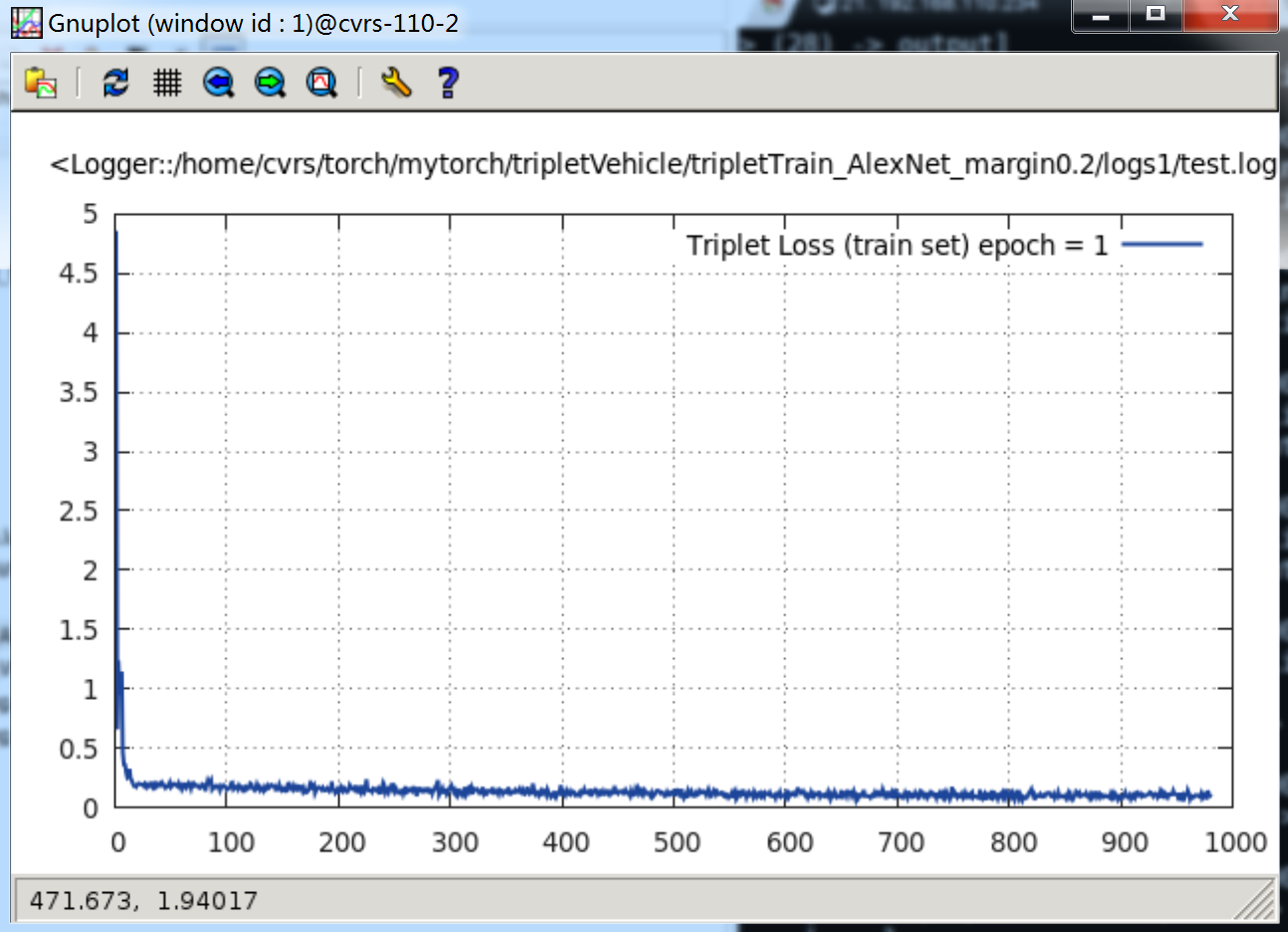
当
epoch = 2时,Loss 曲线如下:

当
epoch = 3时,Loss 曲线如下:
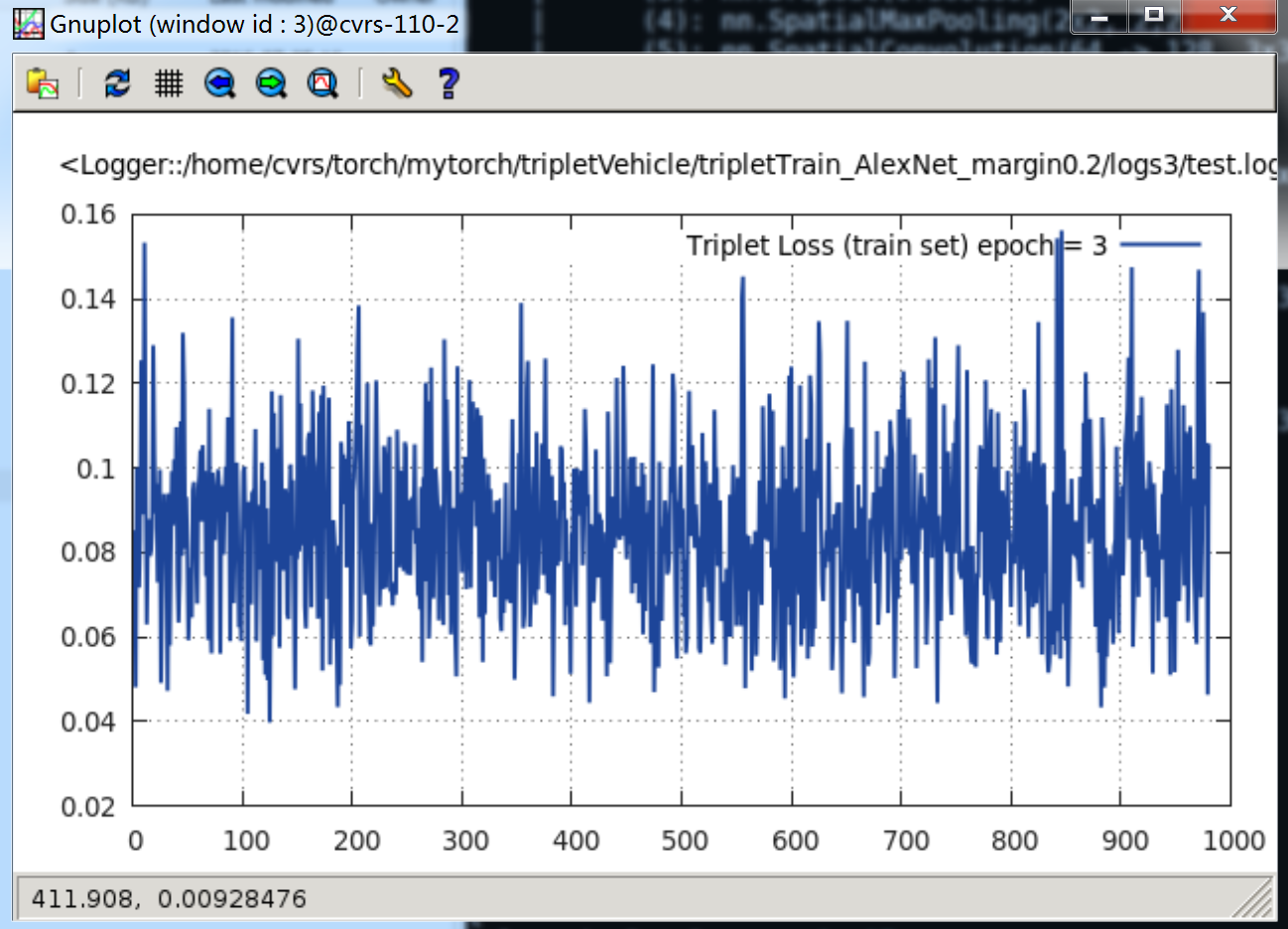
最后,当
epoch = 100时,Loss 曲线如下:
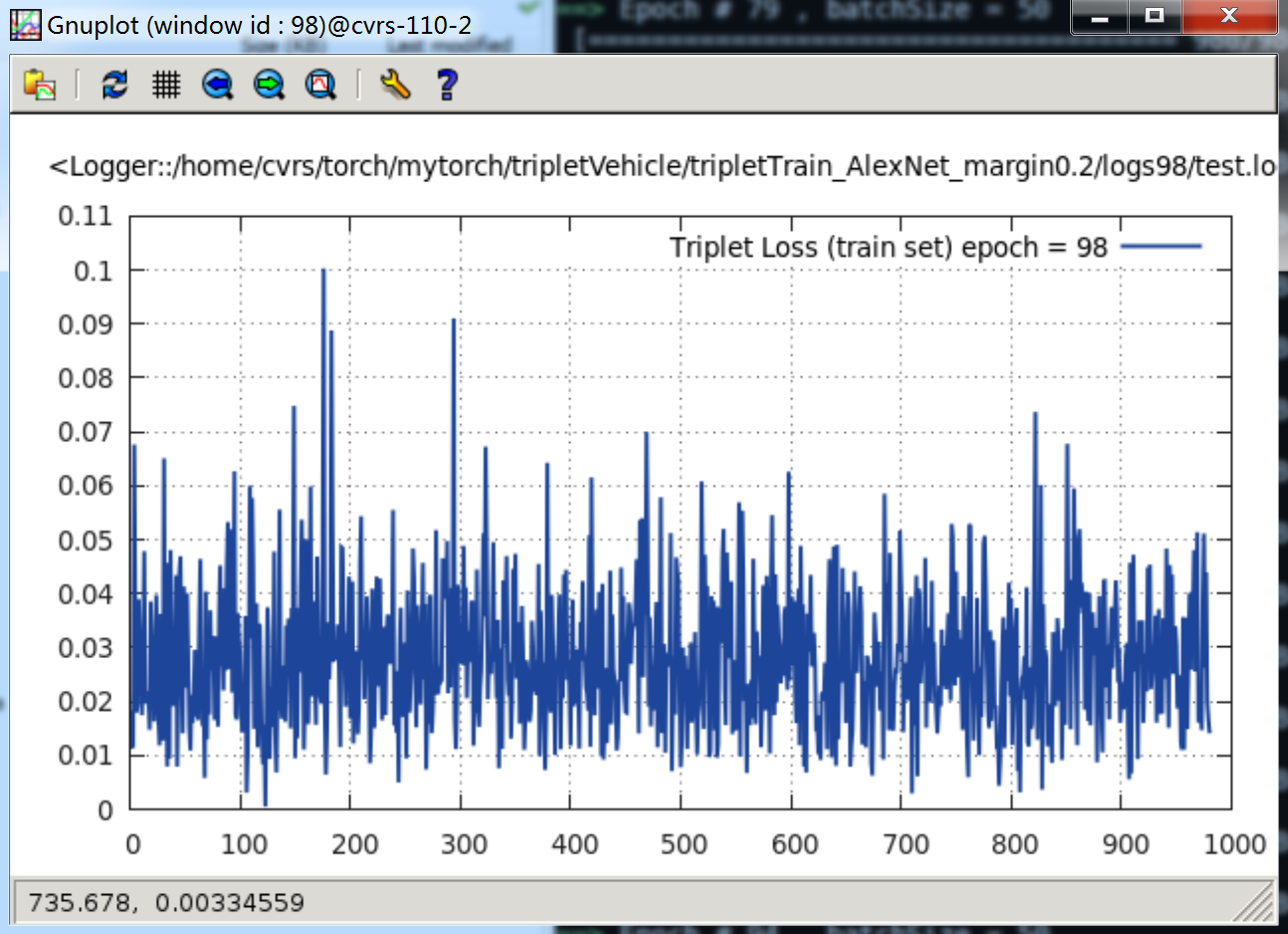
可以看见,最后这个 loss 下降到 0.01 ~ 0.03 之间,其实这还有点大。
Triplet Loss 实验3
下面,当 margin 值设置为 0.5 时,epoch = 1时,loss 曲线如下:
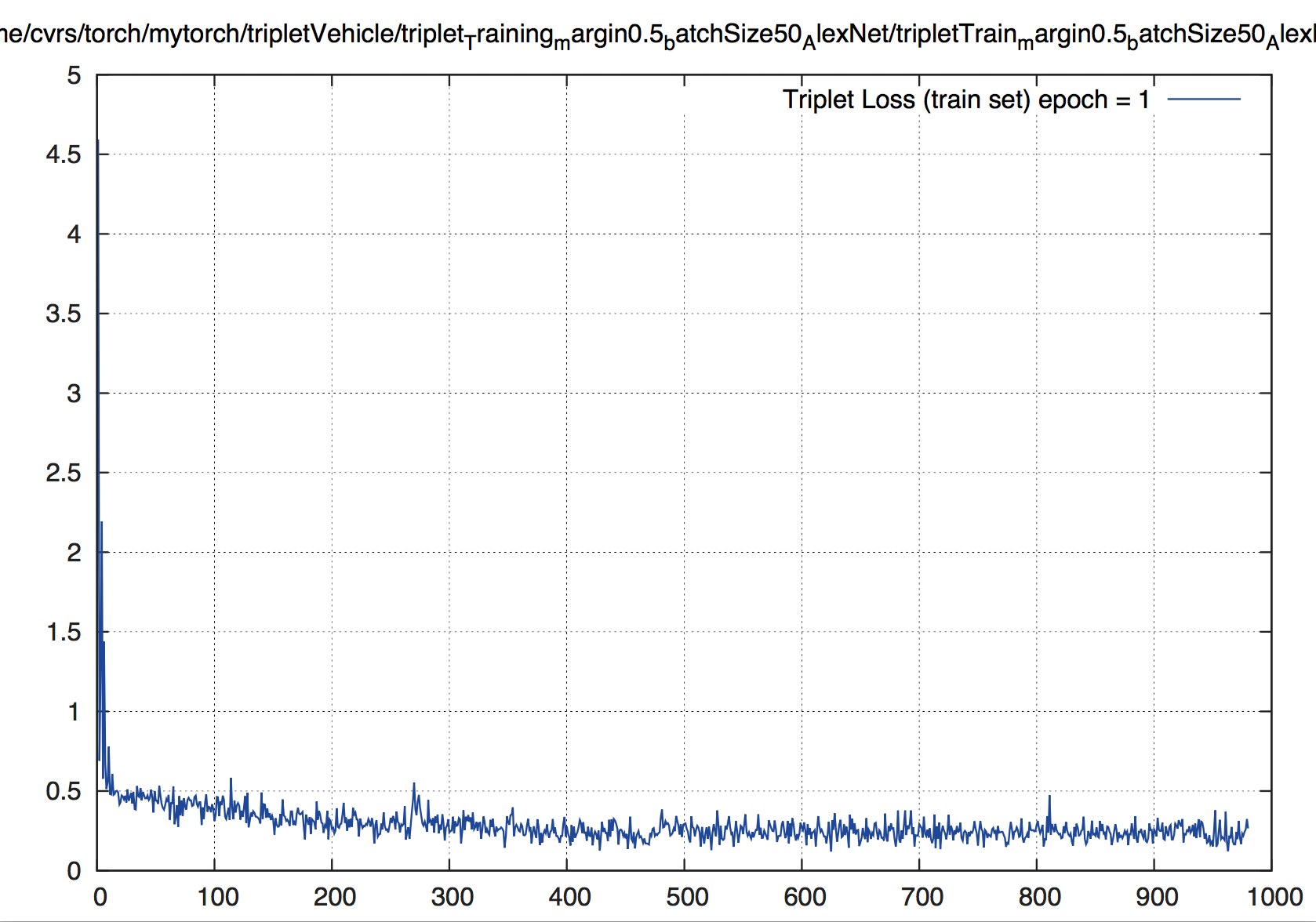
epoch = 2时,loss 曲线如下:
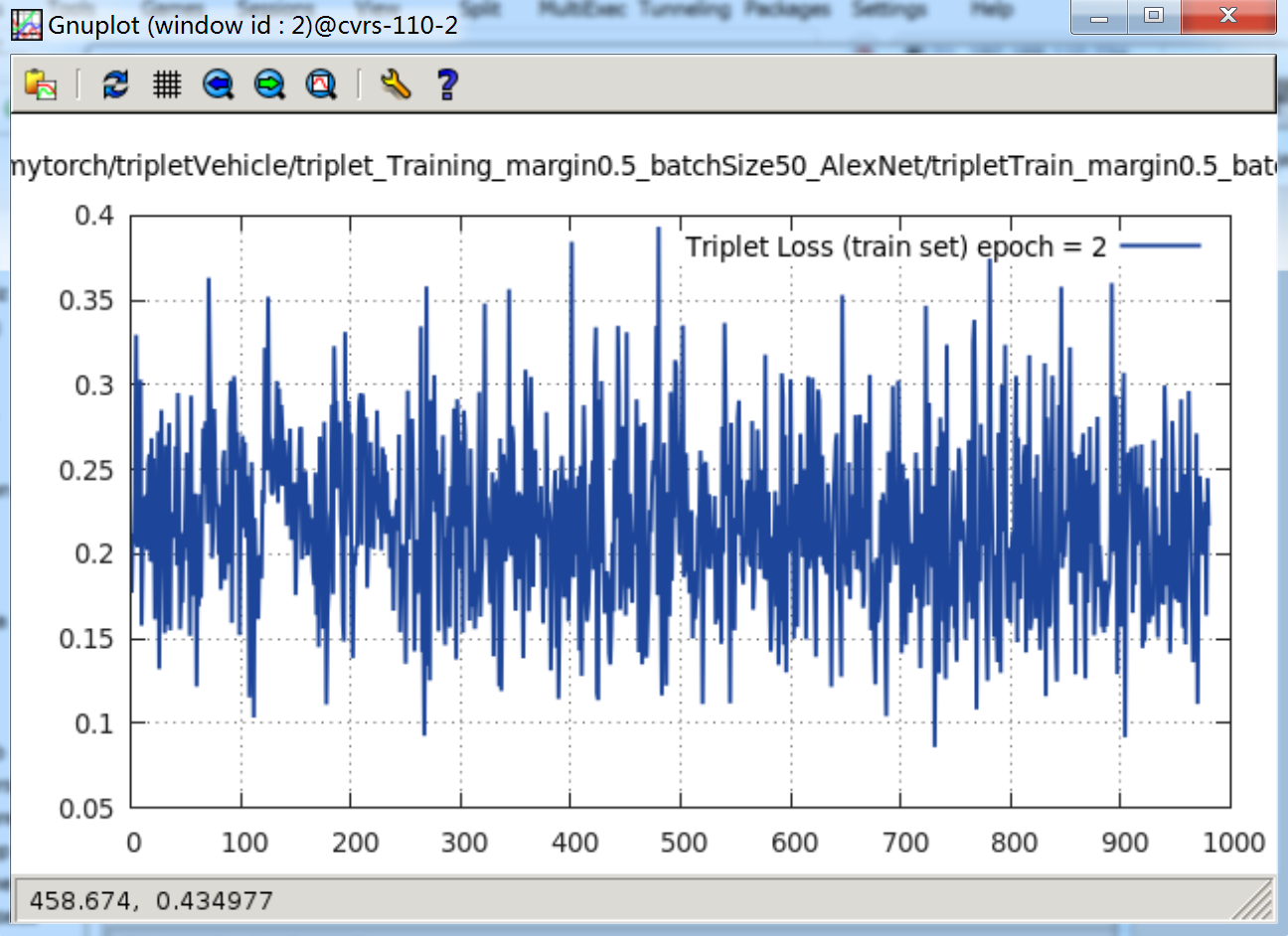
当
epoch = 16时,loss 曲线如下:

当
epoch = 17时,loss 曲线如下:
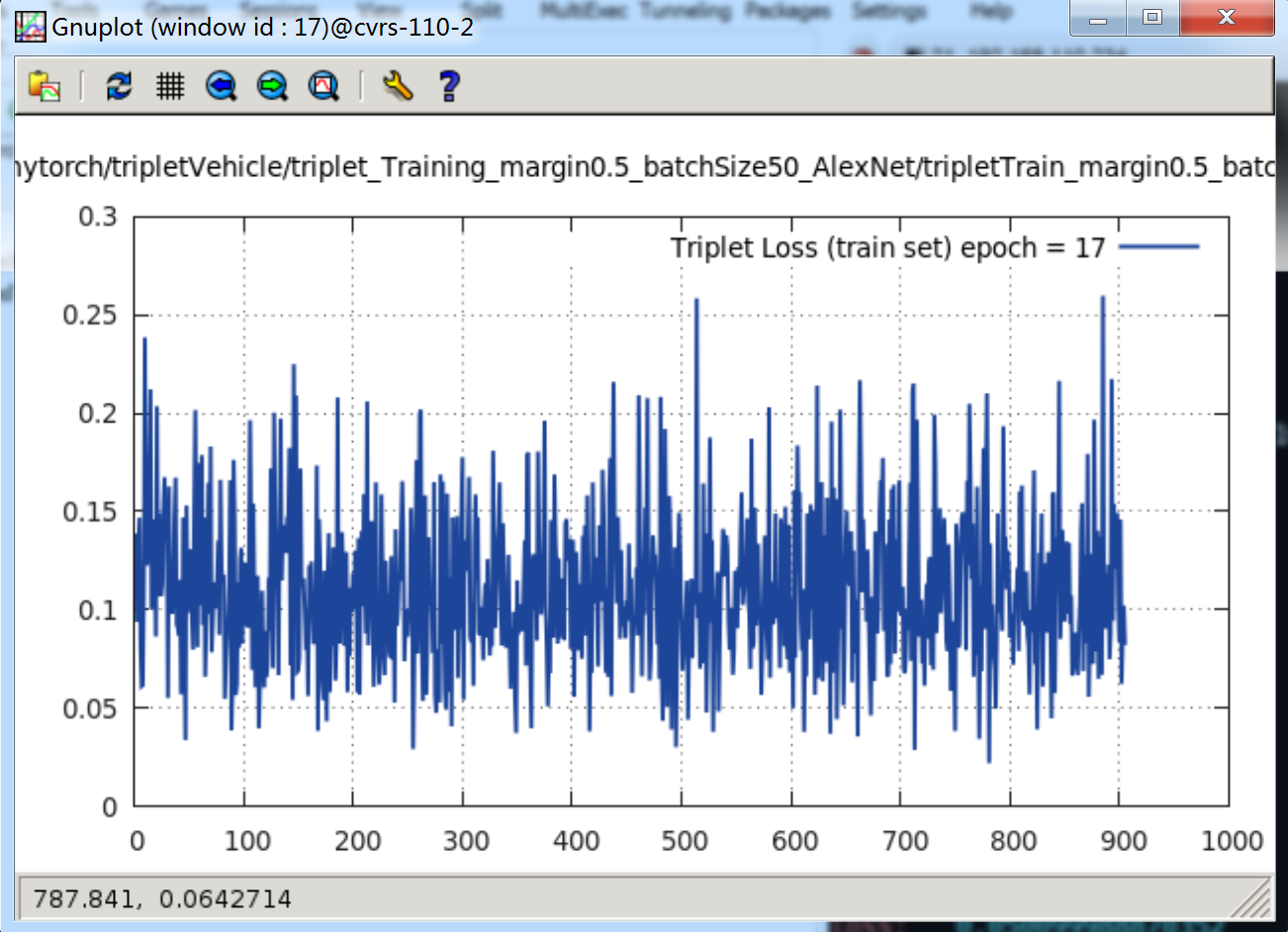
当
epoch = 28时,loss 曲线如下:
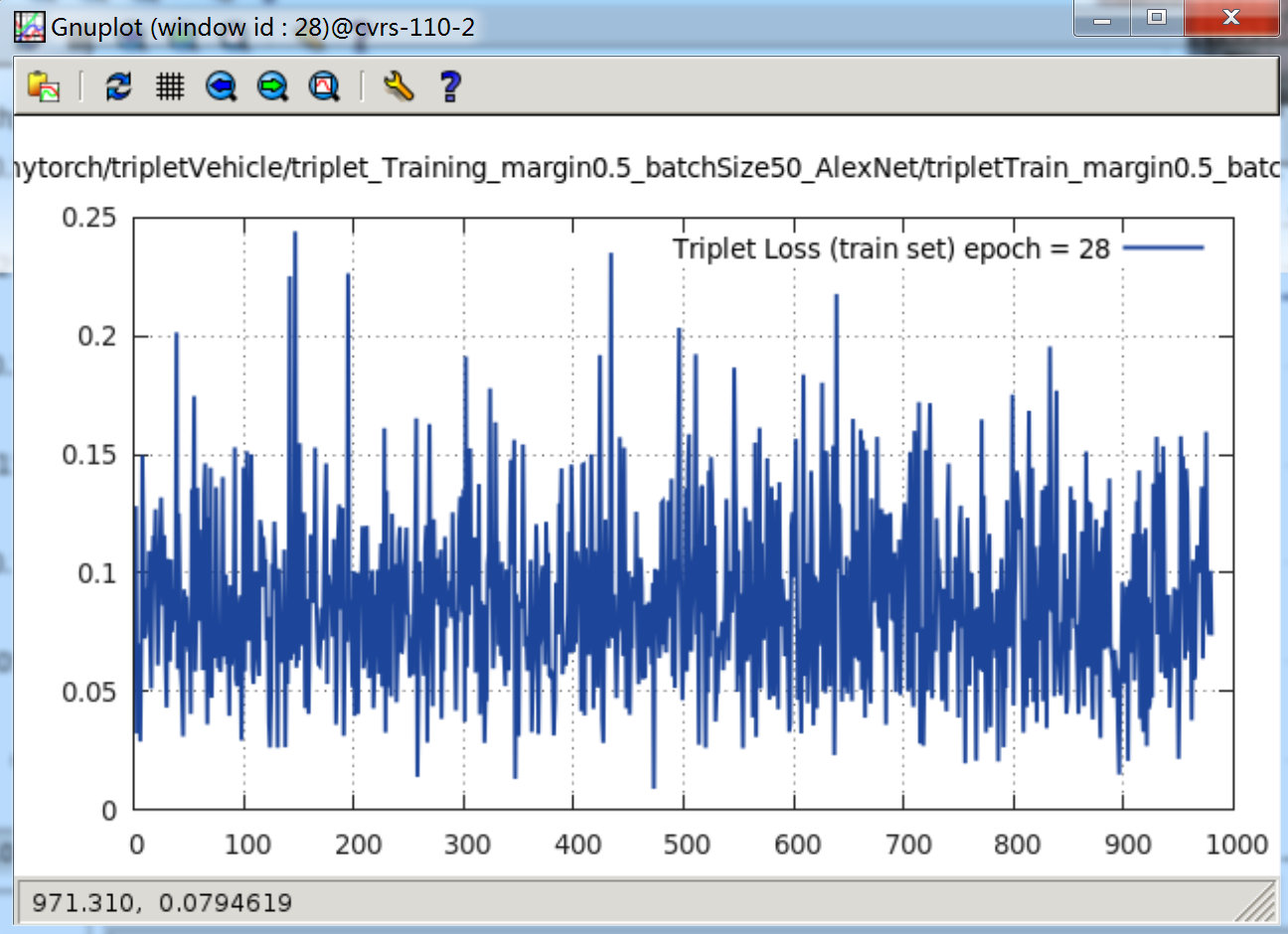
可以看见,其 Loss 一直在下降。
当 margin = 0.2 时,很快的便能下降到 0.1 附近,接着跑一天一夜,loss 便下降到 0.01 ~ 0.03 附近。
当 margin = 0.5 时,很快的便能下降到 0.2 ~ 0.25 附近。接着再跑,loss 就慢慢再下降,经过 17 个纪元,就下降到了 0.1 ~ 0.15 附近。还会进一步下降。
用训练好的 model 进行 predict 测试
这里我折腾了一晚,有点……诡异……我将训练好的模型加载后,传入数据,无论我输入什么 Tensor,模型输出 predict 居然都是一样的值……这里把我郁闷了半天。下面是我用测试图片(Anchor 5 张图像、Positive 5 张图像、Negative 5 张图像)进行模型的测试代码:
require 'nn'
require 'image'
require 'paths'
require 'cunn'
require 'cudnn'
-------------------------------------------------------------
-- load images
-- aImgs: Anchor, pImgs: Positive, nImgs: Negative
-------------------------------------------------------------
aImgs = torch.Tensor(5, 3, 128, 128)
local aImgs_i = 1
for f in paths.iterfiles('tripletTestImgs/aImgs/') do
local img = image.load('tripletTestImgs/aImgs/' .. f)
aImgs[aImgs_i] = image.scale(img, 128, 128)
aImgs_i = aImgs_i + 1
end
pImgs = torch.Tensor(5, 3, 128, 128)
local pImgs_i = 1
for f in paths.iterfiles('tripletTestImgs/pImgs/') do
local img = image.load('tripletTestImgs/pImgs/' .. f)
pImgs[pImgs_i] = image.scale(img, 128, 128)
pImgs_i = pImgs_i + 1
end
nImgs = torch.Tensor(5, 3, 128, 128)
local nImgs_i = 1
for f in paths.iterfiles('tripletTestImgs/nImgs/') do
local img = image.load('tripletTestImgs/nImgs/' .. f)
nImgs[nImgs_i] = image.scale(img, 128, 128)
nImgs_i = nImgs_i + 1
end
-------------------------------------------------------------
-- load trained model
-- margin = 0.2, batchSize = 50, Net = AlexNet
-------------------------------------------------------------
model = torch.load('model_AlexNet.t7')
print(model.modules[1])
print(model.modules[2])
print(model.modules[3])
predict1 = model.modules[1]:forward(aImgs:cuda())
predict2 = model.modules[1]:forward(pImgs:cuda())
predict3 = model.modules[1]:forward(nImgs:cuda())
print('\n---------------------------------------------- \n')
dist1 = torch.sum(torch.cmul(predict1 - predict2, predict1 - predict2), 2)
print('dist1: ');print(dist1)
print('\n----------------------------------------------')
dist2 = torch.sum(torch.cmul(predict1 - predict2, predict1 - predict2), 2)
print('dist2: ');print(dist2)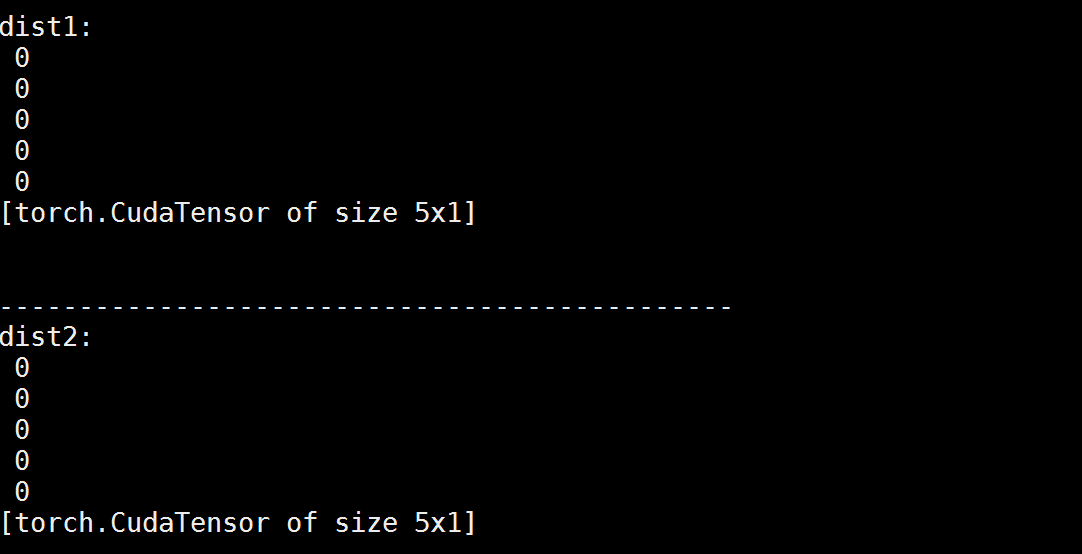
当我把预测部分的代码改成如下:
predict = model:forward({aImgs:cuda(), pImgs:cuda(), nImgs:cuda()})
print('\n---------------------------------------------- \n')
dist1 = torch.sum(torch.cmul(predict[1] - predict[2], predict[1] - predict[2]), 2)
print('dist1: ');print(dist1)
print('\n----------------------------------------------')
dist2 = torch.sum(torch.cmul(predict[1] - predict[3], predict[1] - predict[3]), 2)
print('dist2: ');print(dist2)
print('\n----------------------------------------------')
d1 = torch.sum(torch.cmul(predict[1][1] - predict[1][2], predict[1][1] - predict[1][2]))
print('d1: ' .. d1)
d2 = torch.sum(torch.cmul(predict[1][1] - predict[1][3], predict[1][1] - predict[1][3]))
print('d2: ' .. d2)
d3 = torch.sum(torch.cmul(predict[1][1] - predict[1][4], predict[1][1] - predict[1][4]))
print('d3: ' .. d3)
d4 = torch.sum(torch.cmul(predict[1][1] - predict[1][5], predict[1][1] - predict[1][5]))
print('d4: ' .. d4)
d5 = torch.sum(torch.cmul(predict[1][1] - predict[2][1], predict[1][1] - predict[2][1]))
print('d5: ' .. d5)
d6 = torch.sum(torch.cmul(predict[1][1] - predict[2][2], predict[1][1] - predict[2][2]))
print('d6: ' .. d6)
d7 = torch.sum(torch.cmul(predict[1][1] - predict[2][3], predict[1][1] - predict[2][3]))
print('d7: ' .. d7)
d8 = torch.sum(torch.cmul(predict[1][1] - predict[2][4], predict[1][1] - predict[2][4]))
print('d8: ' .. d8)
d9 = torch.sum(torch.cmul(predict[1][1] - predict[2][5], predict[1][1] - predict[2][5]))
print('d9: ' .. d9)
d10 = torch.sum(torch.cmul(predict[1][1] - predict[3][1], predict[1][1] - predict[3][1]))
print('d10: ' .. d10)
d11 = torch.sum(torch.cmul(predict[1][1] - predict[3][2], predict[1][1] - predict[3][2]))
print('d11: ' .. d11)
d12 = torch.sum(torch.cmul(predict[1][1] - predict[3][3], predict[1][1] - predict[3][3]))
print('d12: ' .. d12)
d13 = torch.sum(torch.cmul(predict[1][1] - predict[3][4], predict[1][1] - predict[3][4]))
print('d13: ' .. d13)
d14 = torch.sum(torch.cmul(predict[1][1] - predict[3][5], predict[1][1] - predict[3][5]))
print('d14: ' .. d14)就有值了:

但奇怪的是,输出的值,每次运行都不一样,如过我再运行一次,就会变成下面的值:

经过 Google,终于找到每次输入,输出的值不一样的原因了!原来是我在网络中加了 Dropout 层,在这个 Torch 的文档中找到了解释:
In this example, we demonstrate how the call to forward samples different
outputsto dropout (the zeros) given the same
input:
module = nn.Dropout()
> x = torch.Tensor{{1, 2, 3, 4}, {5, 6, 7, 8}}
> module:forward(x)
2 0 0 8
10 0 14 0
[torch.DoubleTensor of dimension 2x4]
> module:forward(x)
0 0 6 0
10 0 0 0
[torch.DoubleTensor of dimension 2x4]Triplet Loss 实验4
看来得把 Dropout 的那篇 2014 年 JMLR 的 Paper 《Dropout - A Simple Way to Prevent Neural Networks from Overfitting》 看一下了~于是我干脆将上面网络中的 Dropout 层取消掉,看实验效果。同时参数设置:
margin = 0.5,
batchSize = 50,取消之后的网络为:
-----------------------------------------------------------
-- Network definition --
-- Cut out the Dropout Layer --
-----------------------------------------------------------
backend = nn
convNet = nn.Sequential()
convNet:add(backend.SpatialConvolution(3,64, 3,3, 1,1, 1,1))
convNet:add(backend.ReLU(true))
convNet:add(backend.SpatialMaxPooling(2, 2, 2, 2):ceil())
convNet:add(backend.SpatialConvolution(64, 128, 3,3, 1,1, 1,1))
convNet:add(backend.ReLU(true))
convNet:add(backend.SpatialMaxPooling(2, 2, 2, 2):ceil())
convNet:add(backend.SpatialConvolution(128, 256, 3,3, 1,1, 1,1))
convNet:add(backend.ReLU(true))
convNet:add(backend.SpatialMaxPooling(2, 2, 2, 2):ceil())
convNet:add(backend.SpatialConvolution(256, 512, 3,3, 1,1, 1,1))
convNet:add(backend.ReLU(true))
convNet:add(backend.SpatialMaxPooling(2, 2, 2, 2):ceil())
convNet:add(backend.SpatialConvolution(512, 512, 3,3, 1,1, 1,1))
convNet:add(backend.ReLU(true))
convNet:add(backend.SpatialMaxPooling(2, 2, 2, 2):ceil())
convNet:add(nn.View(512*4*4))
convNet:add(nn.Linear(512*4*4, 4096*4))
convNet:add(nn.ReLU(true))
convNet:add(nn.Linear(4096*4, 4096))
convNet:add(nn.ReLU(true))
convNet:add(nn.Linear(4096, 1024))
-- initialization from MSR
local function MSRinit(net)
local function init(name)
for k, v in pairs(net:findModules(name)) do
local n = v.kW * v.kH * v.nOutputPlane
v.weight:normal(0, math.sqrt(2/n))
v.bias:zero()
end
end
-- have to do for both backends
init'cudnn.SpatialConvolution'
init'nn.SpatialConvolution'
end
MSRinit(convNet)
convNetPos = convNet:clone('weight', 'bias', 'gradWeight', 'gradBias')
convNetNeg = convNet:clone('weight', 'bias', 'gradWeight', 'gradBias')
-- Parallel container
parallel = nn.ParallelTable()
parallel:add(convNet)
parallel:add(convNetPos)
parallel:add(convNetNeg)
parallel = parallel:cuda()
parameters, gradParameters = parallel:getParameters()
print(b('Fresh-embeddings-computation network:')); print(parallel)当
epoch = 1时,其 loss 曲线为:

当
epoch = 2时,其 loss 曲线为:

当
epoch =时,其 loss 曲线为:

突然发现没有了 Dropout 层,训练的 loss 收敛速度要远远快于有 Dropout 层。但同时,每一个 epoch 的速度消耗时间也变长了,是有 Dropout 层所消耗时间的 3 ~ 4 倍:
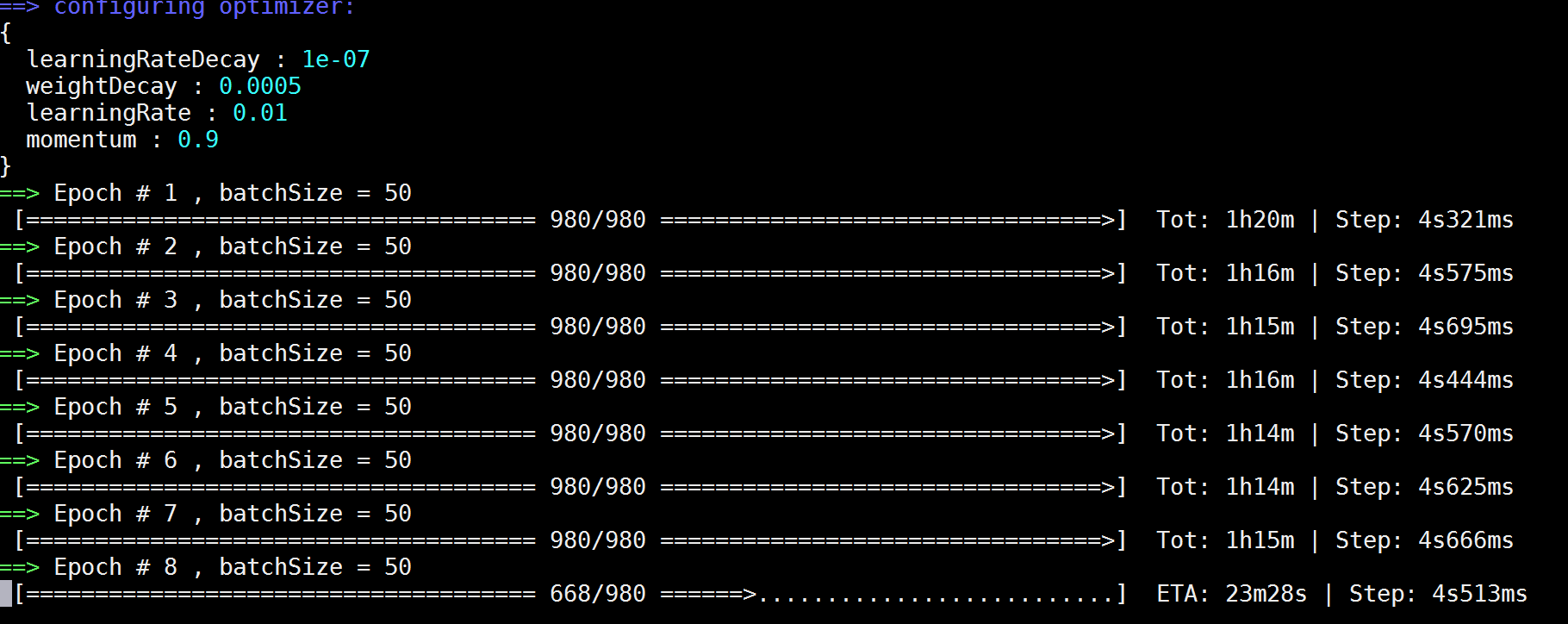
看有 Dropout 层的训练时间消耗:
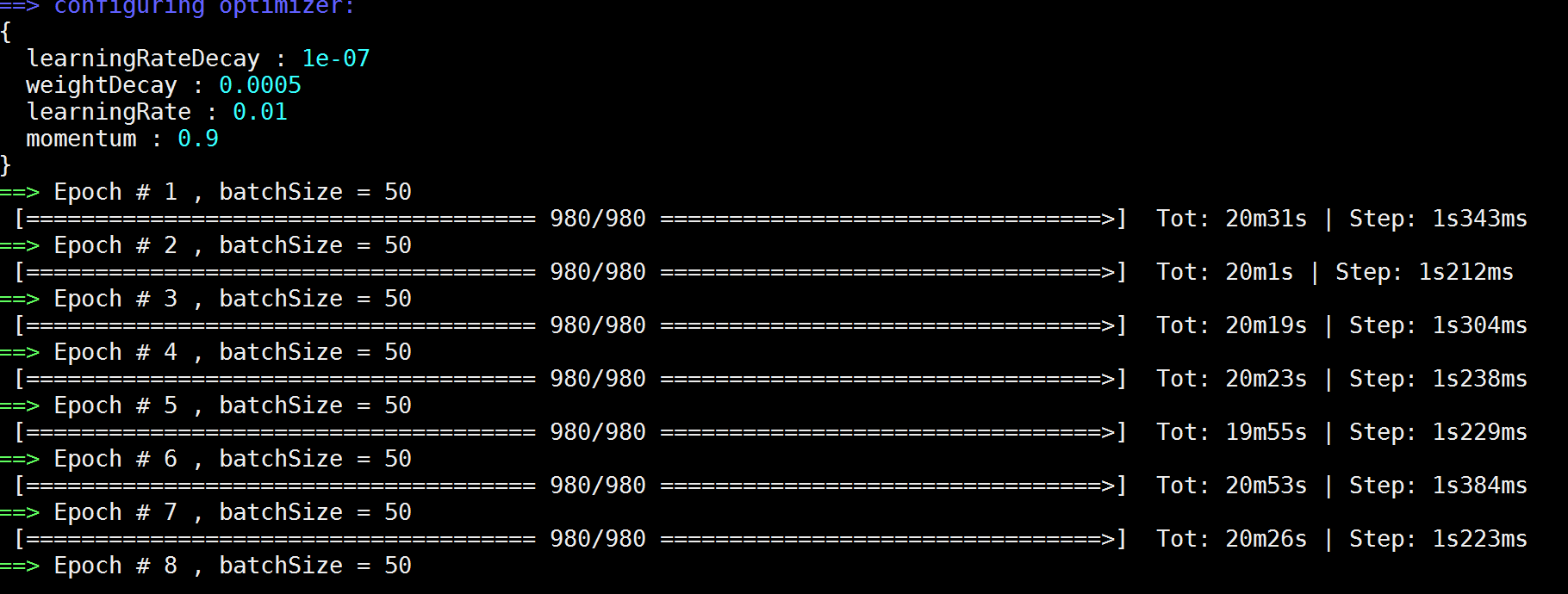
Coupled Cluster Loss
Coupled Cluster Loss 的 Torch 实现
当我将 Triplet Loss 改写为 Coupled Cluster Loss,其损失函数模块的代码如下,这改写没什么难的,依葫芦画瓢就好了:------------------------------------------
-- Coupled Cluster Loss --
-- Xinpeng.Chen --
------------------------------------------
local CoupledClusterLoss, parent = torch.class('nn.CoupledClusterLoss', 'nn.Criterion')
function CoupledClusterLoss:__init(alpha)
parent.__init(self)
self.alpha = alpha or 0.2 -- margin
self.Li = torch.Tensor()
self.gradInput = {}
end
function CoupledClusterLoss:updateOutput(input)
local p = input[1] -- p is the 5 * 1024 vector
local n = input[2] -- n is the 5 * 1024 vector
local N = p:size(1)
-- find the center of the positive points
local centerP = torch.sum(p, 1) / N
-- fing the closest negative vector to the centerP
local negToCP = torch.Tensor(N)
for i = 1, N do
negToCP[i] = torch.sum( torch.cmul(centerP - n[i], centerP - n[i]) )
end
local minNegToCP, minIndex = torch.min(negToCP, 1)
-- Caculate the loss
self.Li:resize(N)
for j = 1, N do
-- self.Li[j] = 0.5 * math.max(0, torch.sum( torch.cmul(p[i] - centerP, p[i] - centerP) ) + self.alpha - torch.sum( torch.cmul(n[minIndex[1]] - centerP, n[minIndex[1]] - centerP) ) )
self.Li[j] = 0.5 * math.max( 0, (p[j] - centerP) * (p[j] - centerP) + self.alpha - (n[minIndex[1]] - centerP) * (n[minIndex[1]] - centerP) )
end
self.output = self.Li:sum()
return self.output
end
function CoupledClusterLoss:updateGradInput(input)
local p = input[1] -- p is the 5 * 1024 vector
local n = input[2] -- n is the 5 * 1024 vector
local N = p:size(1)
-- find the center of the positive points
local centerP = torch.sum(p, 1) / N
-- fing the closest negative vector to the centerP
local negToCP = torch.Tensor(N)
for i = 1, N do
negToCP[i] = torch.sum( torch.cmul(centerP - n[i], centerP - n[i]) )
end
local minNegToCP, minIndex = torch.min(negToCP, 1)
-- Caculate the gradient of input
if torch.type(p) == 'torch.CudaTensor' then -- if buggy CUDA API
self.gradInput[1] = (p - centerP:repeatTensor(N, 1)):cmul(self.Li:gt(0):repeatTensor(p:size(2), 1):type(p:type()) )
self.gradInput[2] = (centerP:repeatTensor(N, 1) - n[minIndex[1]]:repeatTensor(N, 1)):cmul(self.Li:gt(0):repeatTensor(p:size(2), 1):type(p:type()) )
else
self.gradInput[1] = self.Li:gt(0):diag():type(p:type()) * (p - centerP:repeatTensor(N, 1))
self.gradInput[2] = self.Li:gt(0):diag():type(p:type()) * (centerP:repeatTensor(N, 1) - n[minIndex[1]]:repeatTensor(N, 1))
end
return self.gradInput
endCoupled Cluster Loss 的示意图 及其 Loss Function
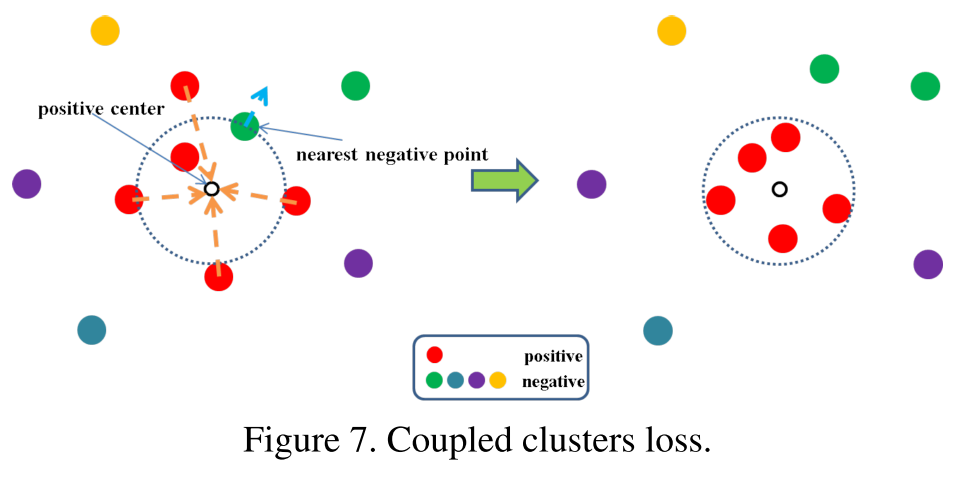
L(W,Xp,Xn)=∑iNp12max{0, ∥∥f(xpi)−cp∥∥22+α−∥∥f(xn∗)−cp∥∥22}
Coupled Cluster Loss 中 margin 取值分析
一开始我比较疑惑,这个 margin 值该怎样设置呢?下面是我的分析:我们的目标是尽量使得 loss 下降到 0,在迭代梯度更新的过程中,要使得第一项:∥∥f(xpi)−cp∥∥22 尽可能的小,即在图中就是使得相似图片与其中心的距离越小越好,而与中心最近的负样本之距离越大越好。
当 margin,即公式中的 α 越大时,就要使得正样本与中心的距离更小,离中心最近的负样本与中心之距离越大,才能使得 loss 将为 0 。
当 margin 越小时,比如设置为 0.05 或者直接是 0 时,正样本与中心的距离就没有必要像 margin 较大时的那样,拼命的”靠在一起”才能使得 loss 为 0,负样本也没必要尽量的与中心”拉远”距离了。
所以,通过上面的分析,这个 margin 很关键。设置的太小,如 0,那么 loss 很容易就下降到 0,因为正样本与中心的距离本应就小于最近负样本与中心的距离。如果设置的太大,那么就很难收敛了,因为无论网络的梯度怎么更新,即使正样本与中心都重合了,最近负样本与中心的距离要”拉得”很远才有可能使得 loss 将为 0 。
Coupled Cluster Loss 实验1
当 Net 为 AlexNet,Margin = 0.5,batchSize = 10 。在第一个纪元,即 epoch = 1 时,其 loss 曲线(因为 trainSize = 49000,所以在一个 epoch 内,共有 4900 次计算迭代,下图只是一部分):
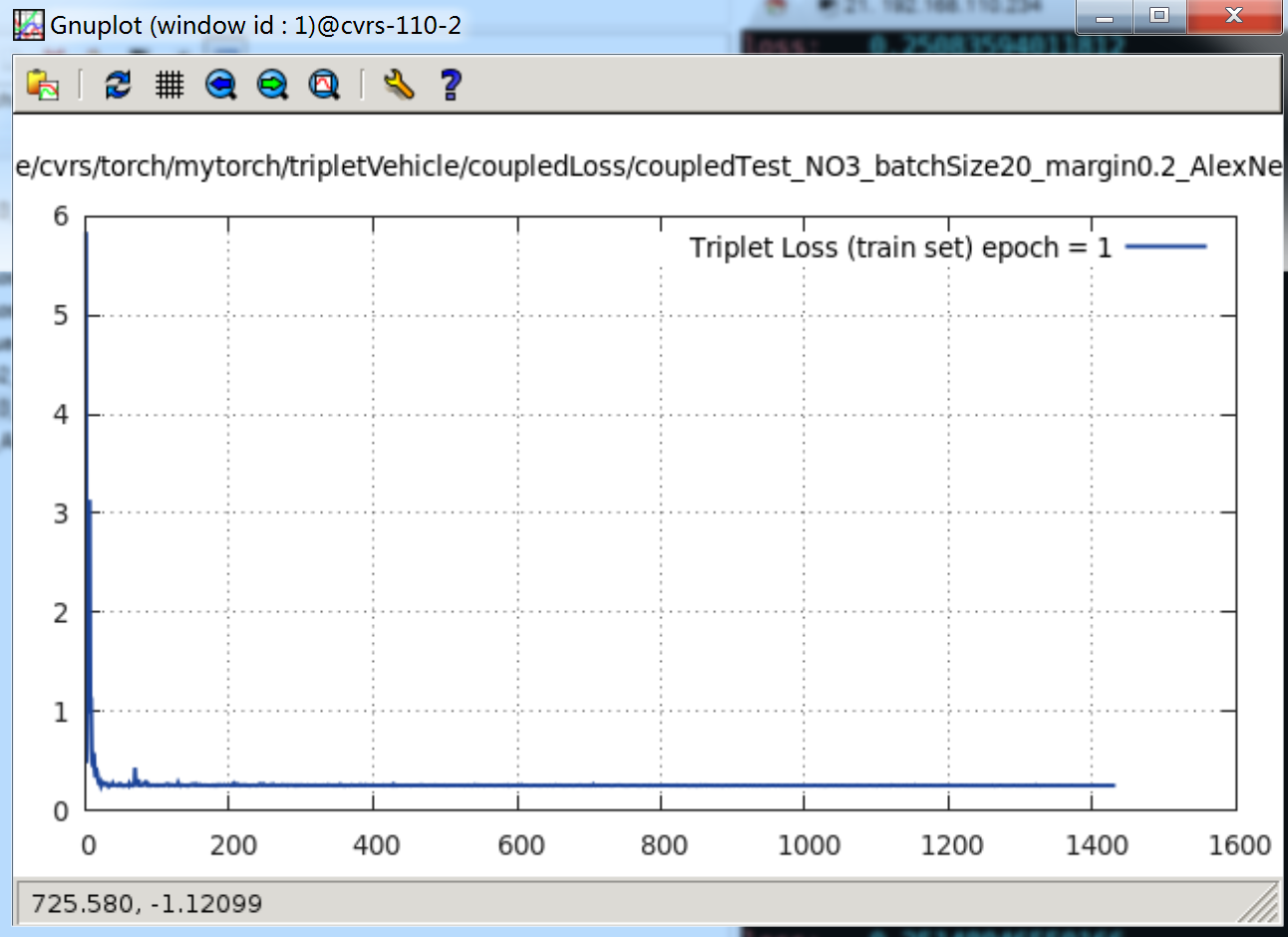
可以看见,loss 很快下降到 0.25 的位置上就很难往下降了。我将 loss 打印出来:
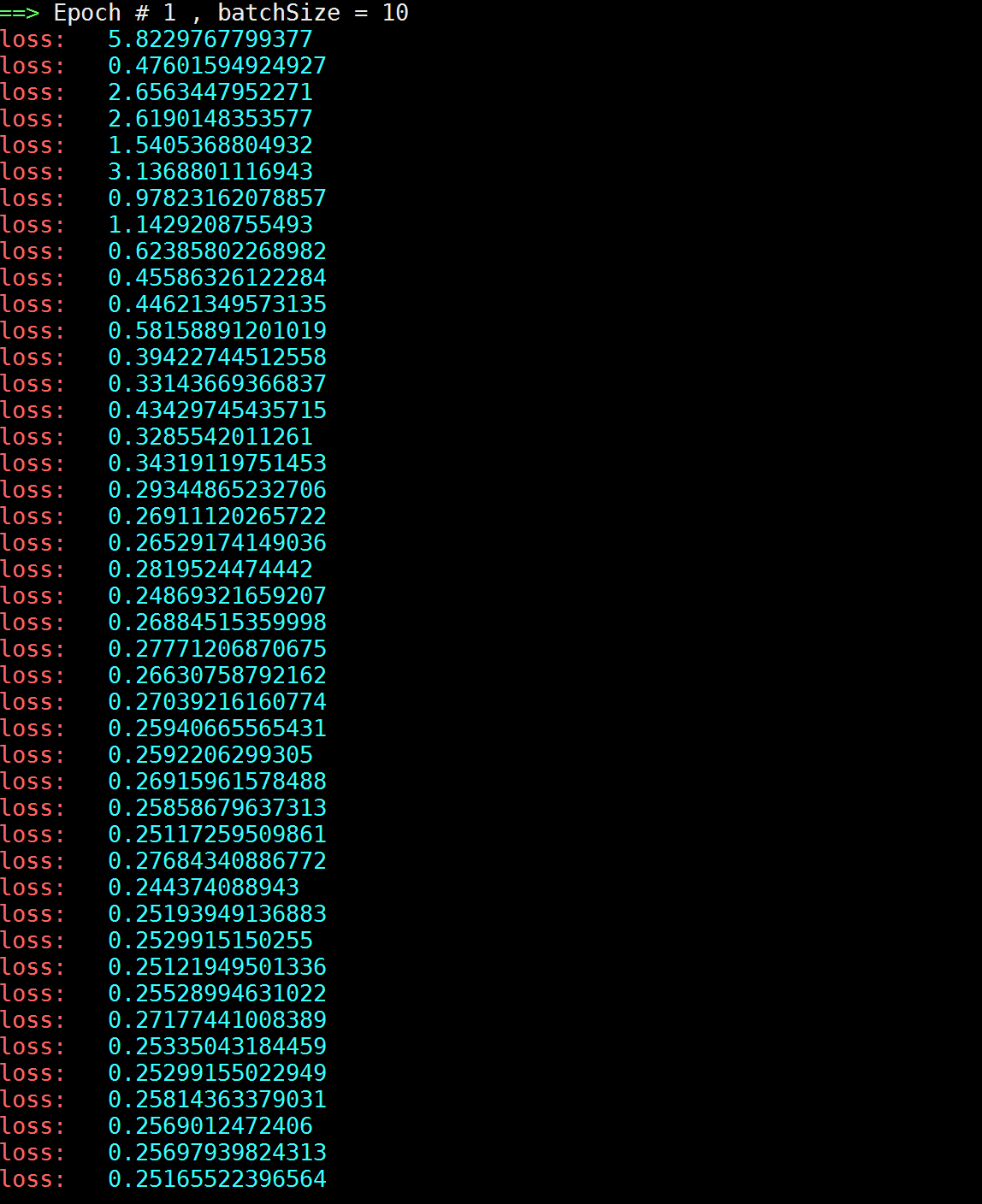
下图是跑了一个晚上,跑到当
epoch = 18时的情况:
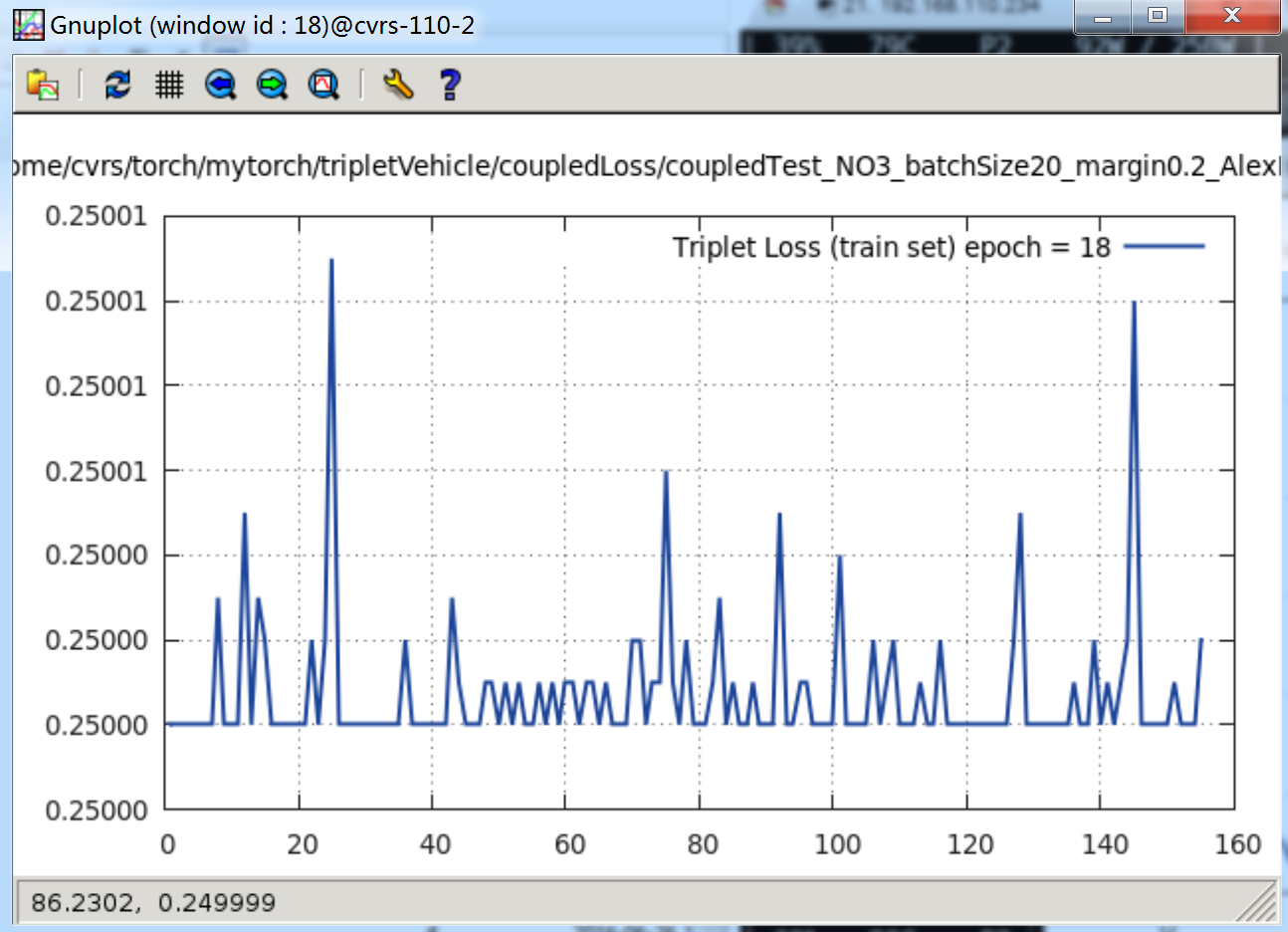
是不是比上面的 Triplet Loss 诡异?就只到 0.25,之后就不再往下降一点点了。
Coupled Cluster Loss 实验2
我开始找原因,是什么导致了这种情况?我注意到,当 margin 取值 0.5 的时候,结合其 loss 函数:L(W,Xp,Xn)=∑iNp12max{0, ∥∥f(xpi)−cp∥∥22+α−∥∥f(xn∗)−cp∥∥22}
0.25 正好是 12×margin,margin 取值 为 0.5。所以,我开始怀疑这篇论文中所提到的 Coupled Cluster Loss 到底合不合适,正不正确?
这时候我将上面损失函数改写一下,就是去掉公式中和 0 的比较::
L(W,Xp,Xn)=∑iNp12( ∥∥f(xpi)−cp∥∥22+α−∥∥f(xn∗)−cp∥∥22 )
但实验结果依然如此,loss 还是降到 0.25 就降不下去:
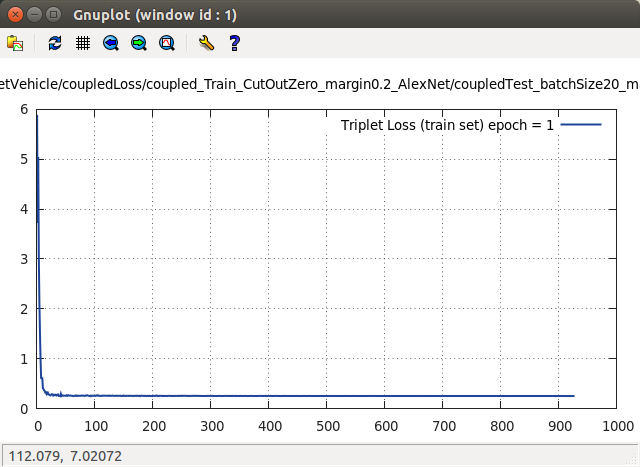
打印出 loss 如下:

Coupled Cluster Loss 实验3
当我的 margin = 1 时,其 loss 还只是下降到一半就不下了: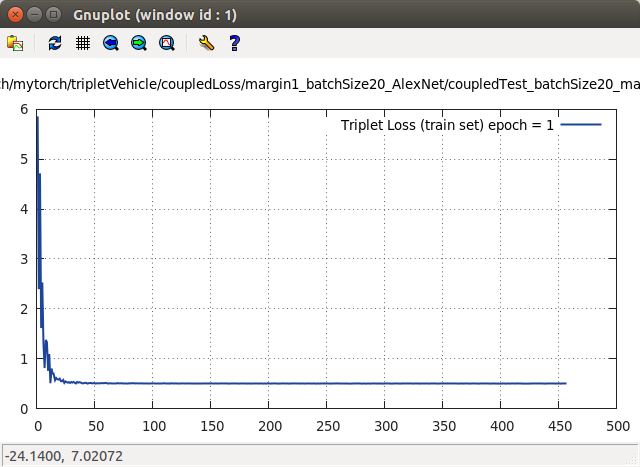
Coupled Cluster Loss 实验4
到这里,我先断了训练,改变 margin 值试试看,我将 margin 改为 0.05 时,其 loss 走势如下: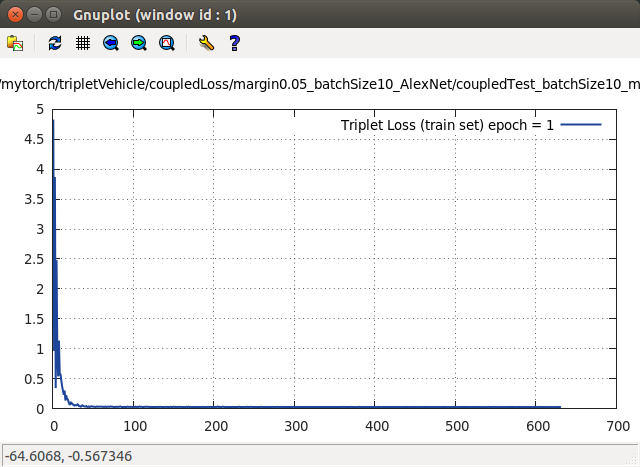
打印出来如下:


从上面可以看见,当 margin = 0.05 时,其 loss 就下降到 0.025 。因此,是不是发现了一个规律?loss 最后的底线值是 margin 值的一半。
Coupled Cluster Loss 实验5
当 margin = 0.01 时,那就是只下降到 0.05,其 loss 曲线如下:当
epoch = 3时,
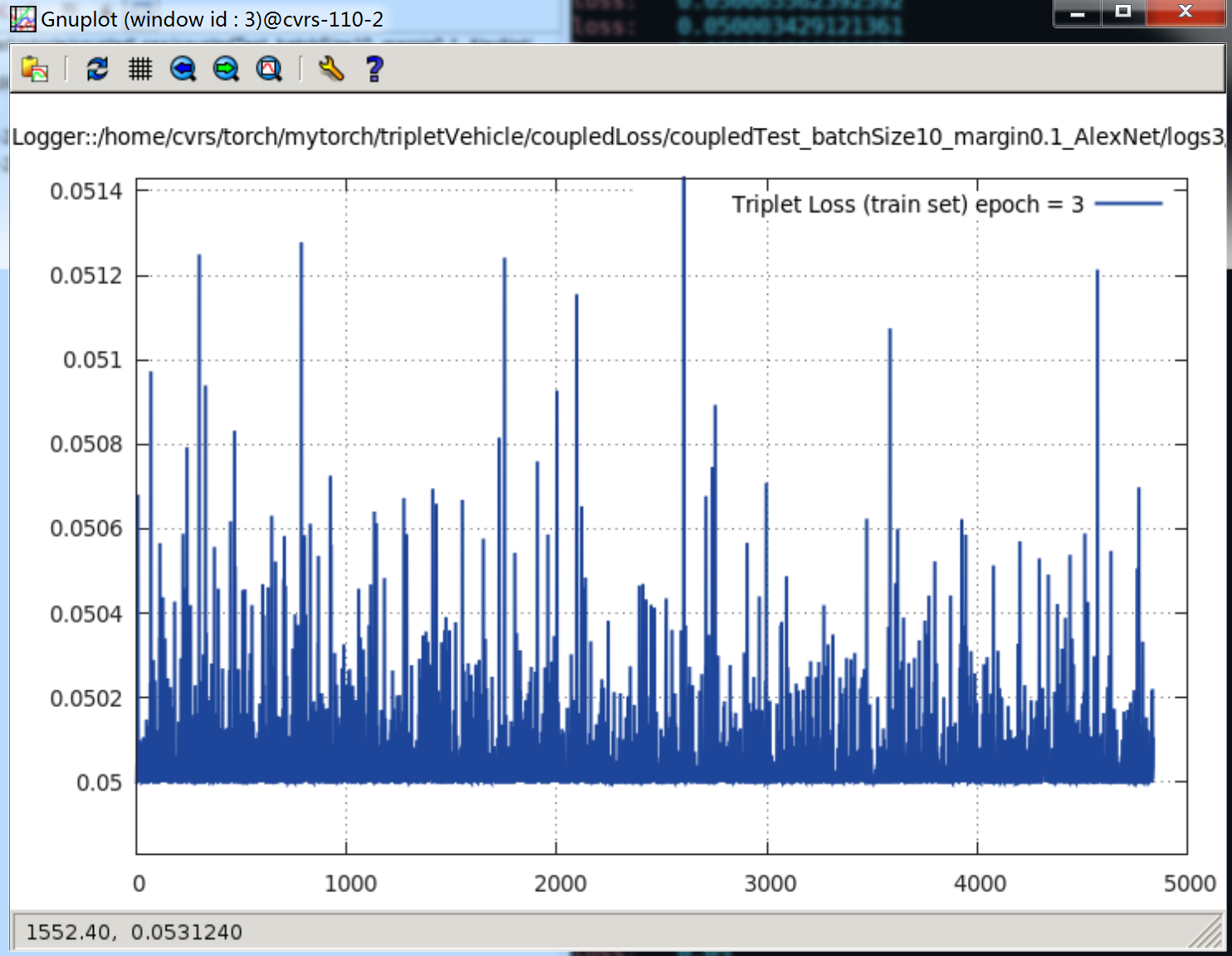
当
epoch = 4时,

看 Terminal 打印出来的内容就更清楚了,只到 0.05,就再不肯往下降一点:

Coupled Cluster Loss 实验发现与猜想、分析
根据上面的实验,所以我猜想 margin 取值与 loss 之间有如下关系:
为什么会这样,我想想,这或许与数据有关系。
几个正样本就很接近,所以损失函数的第一项就几乎为 0,第二项是 margin 的值 α,第三项就是 到中心距离最近的负样本之距离。其实第三项,我想也很接近于 0,因为经过网络的训练,负样本的特征向量与正样本的特征向量差别并不大,都是车,在很难区分的细节上有些差异。
相关文章推荐
- 第九章 事件标志组管理
- Hadoop RPC分析 (二) -- Server
- CodeForces 289A Polo the Penguin and Segments
- logistic regression
- PHP阶段总结
- 由系统的内容提供器读取手机联系人信息
- Team Explorer Everywhere的性能问题
- 选夫婿1
- 我的博客
- Java的值传递
- Linux中命令的使用帮助
- IntelliJ IDE运行Tomcat报错:Unable to ping server at localhost:1099
- mysql索引优化
- 自称我国首款石墨烯基锂电池研制成功
- 学习h5的一丢丢感悟
- 能量项链
- uva10806
- 跨时钟域数据同步
- Hadoop RPC分析(一) -- Client
- 挑选镇长-----2016奇虎360研发工程师内推笔试编程题
